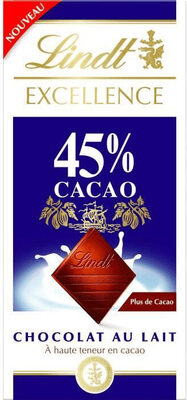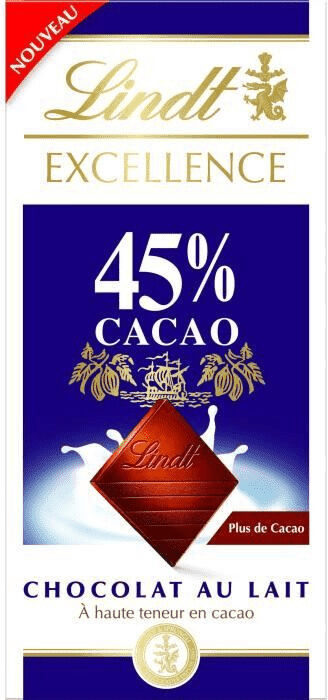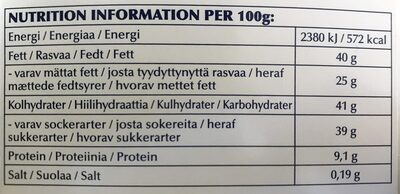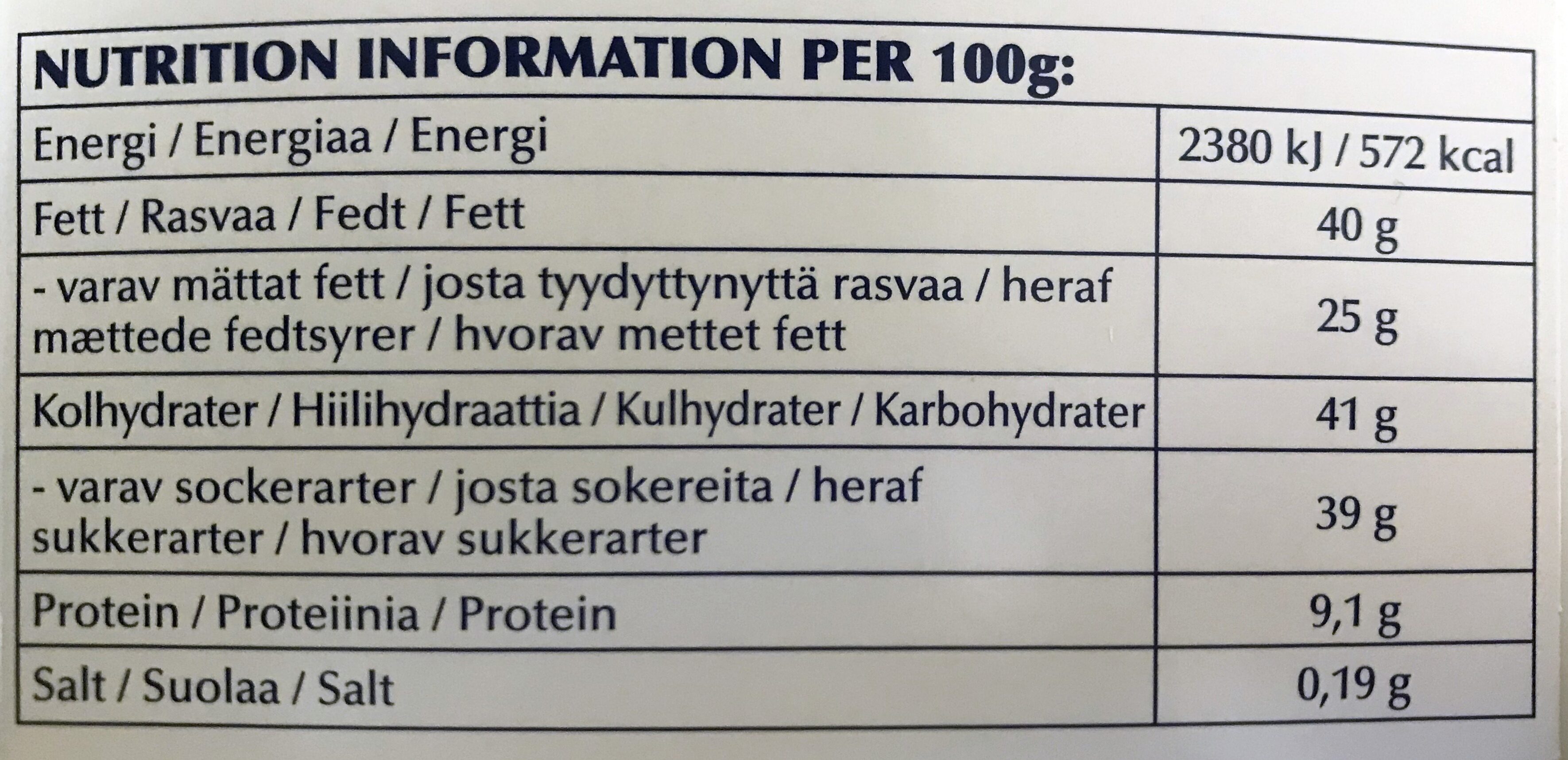Help us make food transparency the norm!
As a non-profit organization, we depend on your donations to continue informing consumers around the world about what they eat.
The food revolution starts with you!
Excellence 45% - Lindt - 80 g
Excellence 45% - Lindt - 80 g
This product page is not complete. You can help to complete it by editing it and adding more data from the photos we have, or by taking more photos using the app for Android or iPhone/iPad. Thank you!
×
Streckkod: 4000539280405 (EAN / EAN-13)
Vanligt namn: Mjölkchoklad med hög kakaohalt
Kvantitet: 80 g
Förpackning: en:Metal, Återvinningsbara metaller, Aluminium, Kartong, 23 PBD
Kategorier: Snacks, Söta snacks, en:Cocoa and its products, Choklad, Mjölkchoklad
Etiketter, certifieringar, utmärkelser:
en:Green Dot, Tillverkad i Tyskland
Ingredients ursprung: Tyskland
Tillverknings eller bearbetningsplats: Deutschland
Länk till produktsidan på producentens officiella webbplats: https://www.lindt.de/produkte/marken/exc...
Butiker: Chocolate Bar, Carrefour market, carrefour.fr
Länder där såld: Danmark, Finland, Frankrike, Tyskland, Norge, Sverige
Matching with your preferences
Hälsa
Ingredienser
-
8 ingredienser
kakaomassa, socker, kakaosmör, _grädd_pulver, _mjölk_pulver, emulgeringsmedel (_soja_lecitin). Kan innehålla hasselnötter, andra nötter. Chokladen innehåller minst 45% kakao och minst 20% mjölk.Allergener: Mjölk, SojaSpår: Nötter
Food processing
-
Ultra processed foods
Elements that indicate the product is in the 4 - Ultra bearbetade livsmedel och drycker group:
- Tillsats: E322 - Lecitiner
- Ingrediens: Emulgeringsmedel
Food products are classified into 4 groups according to their degree of processing:
- Obearbetade eller minimalt bearbetade livsmedel
- Bearbetade kulinariska ingredienser
- Halvfabrikat
- Ultra processed foods
The determination of the group is based on the category of the product and on the ingredients it contains.
Tillsatser
-
E322 - Lecitiner
Lecithin: Lecithin -UK: , US: , from the Greek lekithos, "egg yolk"- is a generic term to designate any group of yellow-brownish fatty substances occurring in animal and plant tissues, which are amphiphilic – they attract both water and fatty substances -and so are both hydrophilic and lipophilic-, and are used for smoothing food textures, dissolving powders -emulsifying-, homogenizing liquid mixtures, and repelling sticking materials.Lecithins are mixtures of glycerophospholipids including phosphatidylcholine, phosphatidylethanolamine, phosphatidylinositol, phosphatidylserine, and phosphatidic acid.Lecithin was first isolated in 1845 by the French chemist and pharmacist Theodore Gobley. In 1850, he named the phosphatidylcholine lécithine. Gobley originally isolated lecithin from egg yolk—λέκιθος lekithos is "egg yolk" in Ancient Greek—and established the complete chemical formula of phosphatidylcholine in 1874; in between, he had demonstrated the presence of lecithin in a variety of biological matters, including venous blood, in human lungs, bile, human brain tissue, fish eggs, fish roe, and chicken and sheep brain. Lecithin can easily be extracted chemically using solvents such as hexane, ethanol, acetone, petroleum ether, benzene, etc., or extraction can be done mechanically. It is usually available from sources such as soybeans, eggs, milk, marine sources, rapeseed, cottonseed, and sunflower. It has low solubility in water, but is an excellent emulsifier. In aqueous solution, its phospholipids can form either liposomes, bilayer sheets, micelles, or lamellar structures, depending on hydration and temperature. This results in a type of surfactant that usually is classified as amphipathic. Lecithin is sold as a food additive and dietary supplement. In cooking, it is sometimes used as an emulsifier and to prevent sticking, for example in nonstick cooking spray.Källa: Wikipedia (Engelska)
-
E322i - Lecitin
Lecithin: Lecithin -UK: , US: , from the Greek lekithos, "egg yolk"- is a generic term to designate any group of yellow-brownish fatty substances occurring in animal and plant tissues, which are amphiphilic – they attract both water and fatty substances -and so are both hydrophilic and lipophilic-, and are used for smoothing food textures, dissolving powders -emulsifying-, homogenizing liquid mixtures, and repelling sticking materials.Lecithins are mixtures of glycerophospholipids including phosphatidylcholine, phosphatidylethanolamine, phosphatidylinositol, phosphatidylserine, and phosphatidic acid.Lecithin was first isolated in 1845 by the French chemist and pharmacist Theodore Gobley. In 1850, he named the phosphatidylcholine lécithine. Gobley originally isolated lecithin from egg yolk—λέκιθος lekithos is "egg yolk" in Ancient Greek—and established the complete chemical formula of phosphatidylcholine in 1874; in between, he had demonstrated the presence of lecithin in a variety of biological matters, including venous blood, in human lungs, bile, human brain tissue, fish eggs, fish roe, and chicken and sheep brain. Lecithin can easily be extracted chemically using solvents such as hexane, ethanol, acetone, petroleum ether, benzene, etc., or extraction can be done mechanically. It is usually available from sources such as soybeans, eggs, milk, marine sources, rapeseed, cottonseed, and sunflower. It has low solubility in water, but is an excellent emulsifier. In aqueous solution, its phospholipids can form either liposomes, bilayer sheets, micelles, or lamellar structures, depending on hydration and temperature. This results in a type of surfactant that usually is classified as amphipathic. Lecithin is sold as a food additive and dietary supplement. In cooking, it is sometimes used as an emulsifier and to prevent sticking, for example in nonstick cooking spray.Källa: Wikipedia (Engelska)
Ingrediensanalys
-
Palmoljefri
No ingredients containing palm oil detected
-
Icke-vegan
Non-vegan ingredients: Grädde, Mjölkpulver
-
Vegetariskt
No non-vegetarian ingredients detected
-
Details of the analysis of the ingredients
: pâte de cacao, sucre, beurre de cacao, crème, poudre de lait, émulsifiant (lécithine de soja), Cacao 45%- pâte de cacao -> en:cocoa-paste - vegan: yes - vegetarian: yes - ciqual_proxy_food_code: 16030
- sucre -> en:sugar - vegan: yes - vegetarian: yes - ciqual_proxy_food_code: 31016
- beurre de cacao -> en:cocoa-butter - vegan: yes - vegetarian: yes - ciqual_food_code: 16030
- crème -> en:cream - vegan: no - vegetarian: yes - ciqual_food_code: 19402
- poudre de lait -> en:milk-powder - vegan: no - vegetarian: yes - ciqual_proxy_food_code: 19044
- émulsifiant -> en:emulsifier
- lécithine de soja -> en:soya-lecithin - vegan: yes - vegetarian: yes - ciqual_food_code: 42200
- Cacao -> en:cocoa - vegan: yes - vegetarian: yes - ciqual_proxy_food_code: 18100 - percent: 45
Näring
-
Bad nutritional quality
⚠ ️Varning: mängden fibrer är inte angiven, eventuella positiv inverkan på betyget kunde inte beaktas.⚠ ️Warning: the amount of fruits, vegetables and nuts is not specified on the label, it was estimated from the list of ingredients: 0This product is not considered a beverage for the calculation of the Nutri-Score.
Positiva poäng: 0
- Proteiner: 5 / 5 (värde: 9.1, avrundat värde: 9.1)
- Fiber: 0 / 5 (värde: 0, avrundat värde: 0)
- Frukt, grönsaker, nötter och raps- / valnöt- / olivoljor: 0 / 5 (värde: 0, avrundat värde: 0)
Negativa poäng: 25
- Energi: 7 / 10 (värde: 2380, avrundat värde: 2380)
- Socker: 8 / 10 (värde: 39, avrundat värde: 39)
- Mättat fett: 10 / 10 (värde: 25, avrundat värde: 25)
- Natrium: 0 / 10 (värde: 76, avrundat värde: 76)
The points for proteins are not counted because the negative points are greater or equal to 11.
Näringsvärde: (25 - 0)
Nutri-Score:
-
Näringsvärden
-
Fett i hög kvantitet (40%)
What you need to know- A high consumption of fat, especially saturated fats, can raise cholesterol, which increases the risk of heart diseases.
Recommendation: Limit the consumption of fat and saturated fat- Choose products with lower fat and saturated fat content.
-
Mättat fett i hög kvantitet (25%)
What you need to know- A high consumption of fat, especially saturated fats, can raise cholesterol, which increases the risk of heart diseases.
Recommendation: Limit the consumption of fat and saturated fat- Choose products with lower fat and saturated fat content.
-
Sockerarter i hög kvantitet (39%)
What you need to know- A high consumption of sugar can cause weight gain and tooth decay. It also augments the risk of type 2 diabetes and cardio-vascular diseases.
Recommendation: Limit the consumption of sugar and sugary drinks- Sugary drinks (such as sodas, fruit beverages, and fruit juices and nectars) should be limited as much as possible (no more than 1 glass a day).
- Choose products with lower sugar content and reduce the consumption of products with added sugars.
-
Salt i låg kvantitet (0.19%)
What you need to know- A high consumption of salt (or sodium) can cause raised blood pressure, which can increase the risk of heart disease and stroke.
- Many people who have high blood pressure do not know it, as there are often no symptoms.
- Most people consume too much salt (on average 9 to 12 grams per day), around twice the recommended maximum level of intake.
Recommendation: Limit the consumption of salt and salted food- Reduce the quantity of salt used when cooking, and don't salt again at the table.
- Limit the consumption of salty snacks and choose products with lower salt content.
-
-
Näringsfakta
Näringsfakta Som såld
för 100 g / 100 mlCompared to: Mjölkchoklad Energi 2 380 kj
(572 kcal)+6 % Fett 40 g +24 % Mättat fett 25 g +34 % Kolhydrat 41 g −21 % Sockerarter 39 g −21 % Fiber ? Protein 9,1 g +10 % Salt 0,19 g −35 % Fruits‚ vegetables‚ nuts and rapeseed‚ walnut and olive oils (estimate from ingredients list analysis) 0 % Cocoa (minimum) 45 % +47 %
Miljö
-
Eco-Score C - Måttlig miljöpåverkan
The Eco-Score is an experimental score that summarizes the environmental impacts of food products.→ The Eco-Score was initially developped for France and it is being extended to other European countries. The Eco-Score formula is subject to change as it is regularly improved to make it more precise and better suited to each country.Life cycle analysis
-
Average impact of products of the same category: D (Score: 38/100)
Kategori: Milk chocolate bar
Kategori: Milk chocolate bar
- PEF environmental score: 0.78 (the lower the score, the lower the impact)
- including impact on climate change: 12.74 kg CO2 eq/kg of product
Stage Impact Jordbruk
43.5 %Bearbetar
50.8 %Förpackning
1.3 %Transportation
3.7 %Distribution
0.6 %Consumption
0.0 %
Bonuses and maluses
-
Origins of ingredients with a medium impact
Bonus: +13
Environmental policy: +4
Transportation: +9
Origin of the product and/or its ingredients % of ingredients Impact Tyskland 100 %Medium
-
Packaging with a low impact
Malus: -4
Form Material Återvinning Impact Okänd Tungt aluminium Recycle Medium Okänd 23 PBD Låg ⚠ ️ The information about the packaging of this product is not sufficiently precise (exact shapes and materials of all components of the packaging).⚠ ️ For a more precise calculation of the Eco-Score, you can modify the product page and add them.
If you are the manufacturer of this product, you can send us the information with our free platform for producers.
Eco-Score for this product
-
Impact for this product: C (Score: 47/100)
Produkt: Excellence 45% - Lindt - 80 g
Life cycle analysis score: 38
Sum of bonuses and maluses: +9
Final score: 47/100
-
Carbon footprint
-
Equal to driving 6.6 km in a petrol car
1274 g CO² per 100g of product
The carbon emission figure comes from ADEME's Agribalyse database, for the category: Milk chocolate bar (Source: ADEME Agribalyse Database)
Stage Impact Jordbruk
31.2 %Bearbetar
65.4 %Förpackning
0.8 %Transportation
2.4 %Distribution
0.1 %Consumption
0.0 %
Förpackning
-
Packaging with a low impact
-
Packaging parts
(Aluminium)
(23 PBD)
-
Packaging materials
Material % Packaging weight Packaging weight per 100 g of product Paper or cardboard Metal Total
-
Transportation
-
Origins of ingredients
Origins of ingredients with a medium impact
Origin of the product and/or its ingredients % of ingredients Impact Tyskland 100 %Medium
Report a problem
-
Incomplete or incorrect information?
Category, labels, ingredients, allergens, nutritional information, photos etc.
If the information does not match the information on the packaging, please complete or correct it. Open Food Facts is a collaborative database, and every contribution is useful for all.
Datakällor
Produkt tillagd den av kiliweb
Senast ändrad produktsida på av ecoscore-impact-estimator.
Produktsida också redigerad av charlesnepote, citrullus28, dahlqvist, didierg, driveoff, inf, jumati, moon-rabbit, openfoodfacts-contributors, packbot, quechoisir, roboto-app, yuka.RnEwWkt2OG9vTjBhdXNVQzNBSHAyOG9sK2FLSGNHL3BNdlFPSVE9PQ, yuka.ZmI0akw3NFluZkFWd3NRdTFCR0pxK3RVbDdpWmNINlNMY01QSVE9PQ, yuka.sY2b0xO6T85zoF3NwEKvlmZnaeL_mwLfOBLfiFLVw9acMKXxQ_dQuaSga6s.










